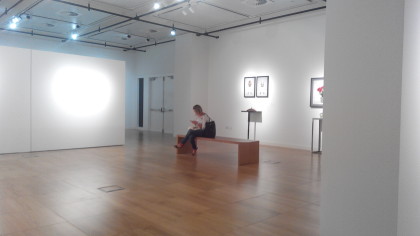Logbook #20
Observing Visitors
Sitting where I was every day allowed me to collect observations about how the visitors would walkthrough the exhibition. While it felt very uncomfortable to be watching people look at my own work, I was able to see if my intended order to the show was actually followed. The visitor would usually begin with the rather long introductory text on the wall with vinyl lettering. They would often then move on to the enormous timeline taking up most of the wall full of examples and explanations to read through- all before even seeing the work.
Placing this timeline at the beginning did mean that I was asking the visitor to read a lot of information before beginning to look at the artworks. But ultimately, the timeline served to set the framework through which to situate the work in the show. The exhibition was reading-heavy overall, with two of the three examples as mostly text-based works. The placement of the timeline meant that it was also the last thing a visitor would see in the exhibition. On their way out, visitors would revisit the timeline after having seen the contemporary examples and read in more detail about how they relate to the history of institutional critique in the catalog essay in their hands.
In general, most people followed the intended order, but it was interesting to watch when some visitors walked through the exhibition in a different order. Sometimes they would go straight from Serkan Ozkaya’s letters to the Gulf Labor work, seeing Babak Golkar’s sculptural installations on their way back to the door. I determined that this was most likely because of the bench placed in front of Babak Golkar’s work- it created a sort of barrier for some from naturally crossing the room in a diagonal to look at Golkar’s works second and instead created a path that kept them on the left side, leading them to turn into the Gulf Labor room.
I hadn’t realized how tricky bench placement would be. I still remember learning about the importance of benches or seating in exhibition spaces as well as carpeting or different floor textures as devices to slow people down in Philippe de Montebello’s J-Term class my freshman year. I knew I wanted to have benches in this exhibition, but I didn’t try to decide on their placement until I was in the space. Still, I didn’t think it would be so hard to make them work in the room. One of the benches was going to be in front of the longer video, however it had to be placed far from the monitor to get no longer see the glare coming from the room’s lighting- so far back, in fact, that the headphone cords would not reach. So we decided that people would have to stand in this this room.
Placing a bench in the middle room, while perhaps complicating the path for some, allowed for a central resting place and I believe that it encouraged visitors to take their time and stay longer. It also became a nice place for me to sit with people and discuss the exhibition- I could stay near the sculptures and have a great conversation with for example, Judy Miller, about my experiences with the capstone process. There was also a bench in the first room, in front of the timeline- this bench was not used for sitting very much since it was near an entrance (although some visitors used it to sit and read some of the catalog essay). Because it was in front of the timeline wall, which really could only be read from standing, this particular bench adopted a practical use I had not anticipated- people would instinctively use it to leave their backpacks and larger bags. By dropping off heavy bags, visitors looked less like they were on their way somewhere, and more like they could take their time with the exhibition.
| Posted in Curatorial Process No Comments;
